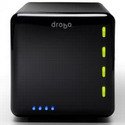 I've changed my home digital storage from a Mac connected to 2 external drives that I striped to RAID 1 using Disk Utility to a Drobo. More specifically, I've changed from a computer that is managing and sharing my storage to a network attached storage (NAS) system. Here's why I did this:
I've changed my home digital storage from a Mac connected to 2 external drives that I striped to RAID 1 using Disk Utility to a Drobo. More specifically, I've changed from a computer that is managing and sharing my storage to a network attached storage (NAS) system. Here's why I did this:- I'm either getting rid of the Mac desktop or plugging it into a TV, so I don't want all of the external drives attached to it anymore (especially if I get rid of it).
- The primary computers in the house are going to be laptops, so I need a storage solution that allows me to connect to it via the network, but doesn't need to be physically connected to any one machine.
- Drobo allows expandability up to 16TB through the insertion of up to 4 SATA drives -- the price of these drives continues to go down and 16TB as an upper-end single device limit seems reasonable to me.
- Data storage needs to be redundant and fault tolerant and the way that Drobo distributes data across multiple drives and reports on impending drive failures is attractive.
- I could have simply plugged the Drobo into the USB on my Airport Extreme and shared the disk, but the Droboshare device is attractive due to the DroboApps that are being developed to make it act more like a lightweight server than just a traditional NAS.
- I like the fact that the NAS can be easily disconnected and the Drobo simply plugged into the USB port of any computer -- this is not functionality normally found on NAS-capable devices.
While certainly not the cheapest NAS solution, I've been very happy with the performance of the Drobo unit thus far. I have initially set up the Drobo with two 1TB drives, which leaves about 1TB free for storage with the other 1TB reserved for data redundancy. My previous set-up was two 250GB drives striped for RAID 1, which left about 250GB for storage, so I've effectively quadrupled my storage capacity and built in expansion. Furthermore, the external drives I was using did not have any external warnings for drive failure or the ability to hot swap drives.
As I mentioned, one of the exciting parts of the Drobo, and specifically Droboshare, is DroboApps. Two apps in particular are very cool: Yoics, which allows me to access the Drobo remotely via the web and Firefly, which is an iTunes Media Server (i.e., you point it to your music files, and they show up as a shared library for iTunes-capable devices connected to the network). Essentially Droboshare is a lightweight Linux server, so there are people writing all kinds of software for it.
My biggest challenge right now is figuring out how to back up everything on the Drobo into the cloud. Ideally Jungledisk or someone similar would write an application for Droboshare that would allow it to back things up by itself without needing a connected computer to do it for you.
Link -- Drobo main page
Link -- Drobo purchase on Amazon
Link -- Droboshare purchase on Amazon
As I mentioned, one of the exciting parts of the Drobo, and specifically Droboshare, is DroboApps. Two apps in particular are very cool: Yoics, which allows me to access the Drobo remotely via the web and Firefly, which is an iTunes Media Server (i.e., you point it to your music files, and they show up as a shared library for iTunes-capable devices connected to the network). Essentially Droboshare is a lightweight Linux server, so there are people writing all kinds of software for it.
My biggest challenge right now is figuring out how to back up everything on the Drobo into the cloud. Ideally Jungledisk or someone similar would write an application for Droboshare that would allow it to back things up by itself without needing a connected computer to do it for you.
Link -- Drobo main page
Link -- Drobo purchase on Amazon
Link -- Droboshare purchase on Amazon
No comments:
Post a Comment